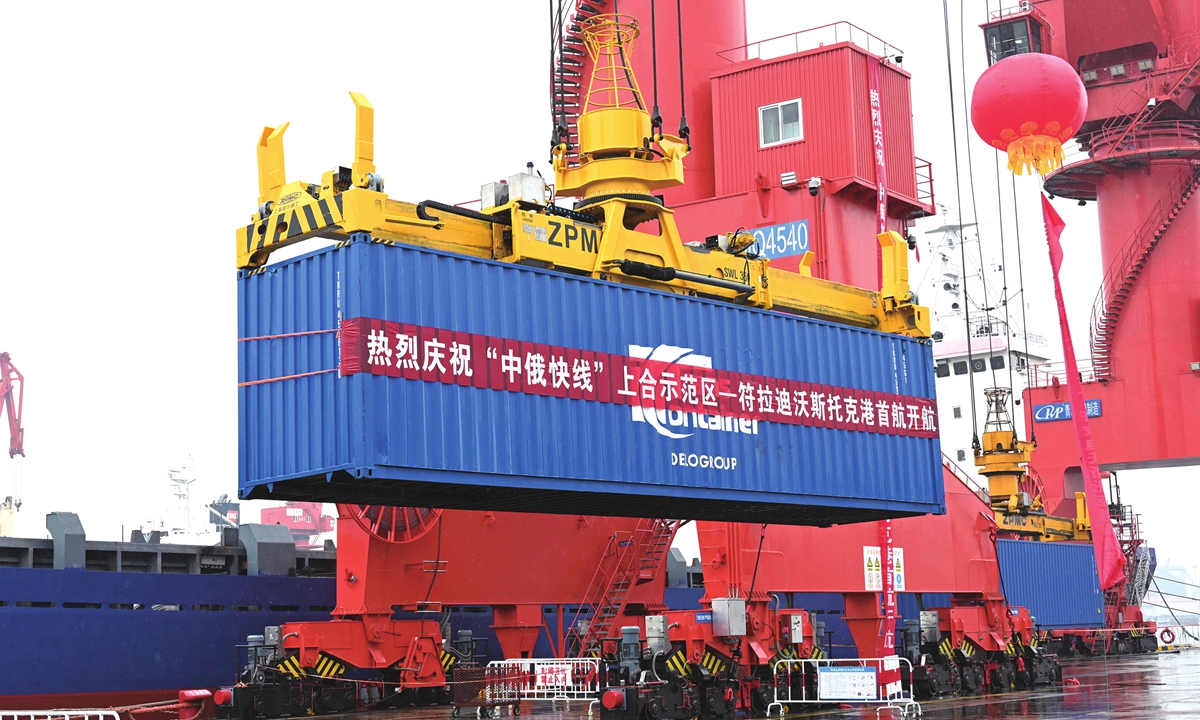China-Russia trade, regional economic development gets boost with Vladivostok being new transit port for domestic trade
Industry insiders tap into business potential with Vladivostok being transit hub for domestic trade

The China-Russia Express from China-SCO Local Economic and Trade Cooperation Demonstration Area (SCODA) to Vladivostok port in Russia starts its maiden voyage in Qingdao, East China's Shandong Province on September 14, 2022. This is the first cargo ship from SCODA to Russia's Far East and the express will get to Vladivostok port at least 10 days sooner. Photo: cnsphoto
China-Russia trade and the regional economy in Northeast China will be further boosted with the opening of a new transshipment port for cross-border transportation of domestic trade in Vladivostok in Russia's Far East, which takes effect on Thursday, amid the growing need for regional economic development.
Vladivostok, now the largest Russian port on the Pacific Ocean, also known historically as Haishenwai in Chinese, will enable traders to diversify their routes and cut transport costs, particularly between industrial hubs in the northeast and manufacturing and trade centers in South China, industry insiders said.
The new transit port, as a win-win cooperative mechanism, is expected to bring benefits for regional economic development in Northeast China as well as Russia's Far East, ultimately injecting new impetus into bilateral trade and investment, experts said.
The decision to launch the new port came amid China's strategic deployment of revitalizing the old industrial base in the northeast and promoting cooperation with overseas ports in the cross-border transportation of domestic trade, per a recent notice from the General Administration of Customs (GAC).
Zhoushan Yongzhou Container Terminal and Jiaxing Zhapu Port in East China's Zhejiang Province will be added as entry ports for the cross-border transportation of domestic trade with Vladivostok.
Jilin and Heilongjiang provinces in Northeast China have long been hampered in their economic and trade development because there is no outlet to the sea.
The nearest and most-used domestic trade transit route in the region now is through Dalian in Liaoning Province, which often means a trip of more than 1,000 kilometers. The distance between Vladivostok and major regional trade hubs such as Northeast China's Suifenhe and Hunchun is only about 200 kilometers, a big shortcut that will greatly cut logistics costs, Kang Shuchun, a director of the China Federation of Logistics and Purchasing, told the Global Times.
With the shorter distance, the delivery fee for each container transported from Hunchun to Zhoushan Yongzhou Container Terminal via Vladivostok may be reduced by at least 2,000 yuan ($281), Kang said.
There are now 13 trade routes with Russia, mostly scheduled on a weekly basis, and they are very busy, an employee with one of the entry ports for the cross-border transportation of domestic trade in Zhejiang told the Global Times on condition of anonymity.
The traded goods are in a wide range of categories ranging from daily commodities to cars.
"After Vladivostok is opened as a domestic trade port, voyage adjustments will be made according to available arrangements. Many freight forwarders are interested in this soon-to-open route, and they contact us for consultation," the person said.
In addition to boosting the regional economy and trade cooperation between China and Russia, the new transit port will enable more goods made in Northeast China to be exported at competitive prices to South Korea, Japan and even Southeast Asia, the industry expert said.
Zhang Hong, a research fellow at the Institute of Russian, Eastern European and Central Asian Studies of the Chinese Academy of Social Sciences, told the Global Times that in addition to providing new possibilities for bulk commodity trade in Northeast China, the new transit port will strengthen logistics cooperation between China and Russia's Far East.
"Investment and trade in sectors such as energy will be tapped into," Zhang said.
While agricultural products and vehicles produced in Northeast China can be quickly transported to the market in the south via the new route, border crossings involve customs supervision, according to media reports.
Having Russia's Vladivostok as part of the transit port system for domestic trade is part of the follow-up efforts by the Chinese government to bolster regional economic and trade.
In 2020, Russia's Slavyanka sea port and Kraskino Highway Port were included as transshipment ports for the cross-border transportation of domestic trade goods in Jilin Province.
An expert said that the actual economic effect of the new transit port will take time to emerge.
The new port will be one of many options, rather than the only choice available. There are already three cross-border ports in Jilin in operation, with one connecting North Korea and the other two with Russia, Zhang said.
Due to the vast land and sparse population in the Far East, investment in infrastructure may not yield benefits in the near term, the expert said.



